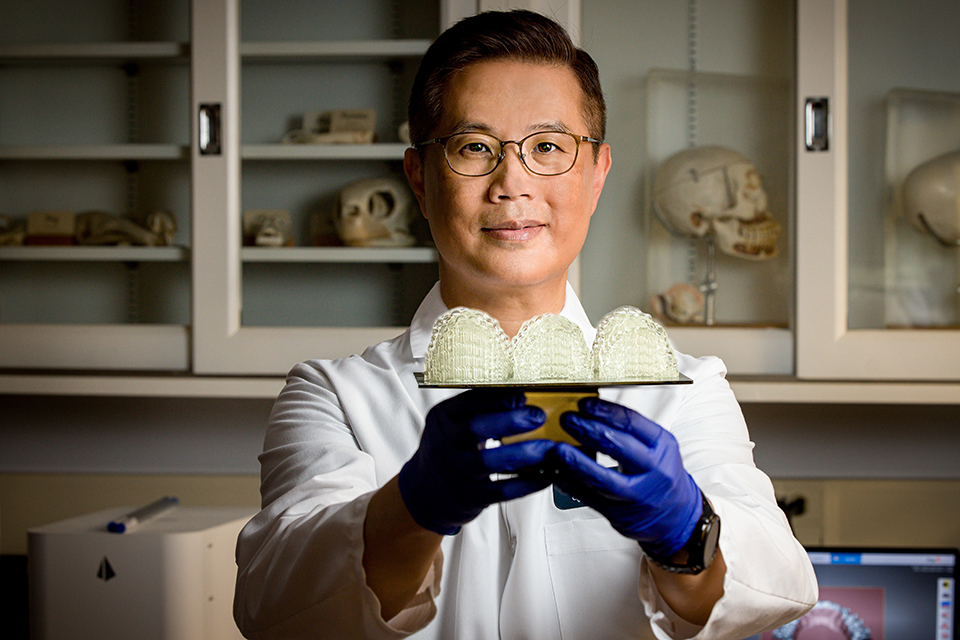Pandemic Sparks Key Innovations in Digital Orthodontics at SLU’s Center for Advanced Dental Education
Bridjes O'Neil
Communications Specialist
bridjes.oneil@slu.edu
314-282-5007
Reserved for members of the media.
ST. LOUIS – The COVID-19 pandemic galvanized researchers at Saint Louis University’s Center for Advanced Dental Education (CADE) to explore key innovations in digital orthodontics and general dentistry.
Now, dental professionals from various countries are traveling to SLU to learn more about two technological advancements not available anywhere else in the world.
Ki Beom Kim, D.D.S., Ph.D., the Dr. Lysle Johnston Endowed Chair in Orthodontics, and the program director in the Orthodontic Department at CADE, says the pandemic intensified the need for digital orthodontics as many clinics were shut due to lockdowns and movement restrictions. COVID-19 swept away many of these barriers, leading to the rapid adoption of digital solutions and transforming ways of working and service delivery.
“Orthodontics is a thinking game, like chess. You’re constantly maneuvering pieces to solve problems that will not only improve a patient’s smile but their quality of life,” Kim said.
Through a partnership with Graphy, a South Korean 3D printing material company, SLU researchers have spent the past three years testing direct 3D–printed aligners.
The researchers found that controlling material dimensions, structure, and properties of aligners directly — compared to thermoforming plastic sheets like Invisalign — has the potential to make the process of tooth movement faster, less wasteful and more precise.
Their findings were recently published in the Progress in Orthodontics paper “Force Profile Assessment of Direct-Printed Aligners Versus Thermoformed Aligners and the Effects of Non-Engaged Surface Patterns.”
Kim says it’s a significant development with the potential to take 10%, or more than $5 billion, of Invisalign’s market share.
“Invisalign is a $25 billion company. There’s commercial interest from many companies trying to develop this type of material, but we are the first school to do so,” Kim said.
Kim highlights that retention in orthodontics has long been a challenging aspect. While many orthodontists recognize the advantages of using fixed retainers, there are typically two factors that hinder their widespread adoption. The first concern is the time-consuming nature of the process, and the second revolves around potential tooth movement due to wire untwisting, as highlighted in case reports of improperly bent wires.
Addressing this issue, YOAT, a medical technology manufacturer based in Seattle, has successfully revolutionized the field of orthodontics. By collaborating with YOAT, Saint Louis University is currently testing an on-site retainer-bending machine that promises to create precise retainers while drastically reducing the time required for alterations. Early results from the study have already shown that patients experience improved stability compared to traditional retainers.
In the past, orthodontists had to manually bend retainer wires. SLU's partnership with YOAT extends to developing a finishing wire bending machine, scheduled for testing this fall. The introduction of this new machine is expected to further elevate treatment quality by offering customized finishing wire options, pushing the boundaries of orthodontic care.
Other researchers on the paper include Evan Hertan, D.D.S.; Julie McCray, D.D.S.; and Brent Bankhead, D.D.S. from Saint Louis University. The paper’s digital object identifier is: https://doi.org/10.1186/s40510-022-00443-2.
About The Center for Advanced Dental Education
The Center for Advanced Dental Education's mission is to achieve the highest level of excellence in scholarship and patient care while educating dentists in the specialties of orthodontics (tooth straightening), endodontics (root canal treatment), pediatric dentistry and periodontics (gum disease therapy). The center aims to serve its students, the profession of dentistry, the community of St. Louis, and the communities in which the graduates of CADE will practice their dental specialty.
About Saint Louis University
Founded in 1818, Saint Louis University is one of the nation’s oldest and most prestigious Catholic institutions. Rooted in Jesuit values and its pioneering history as the first university west of the Mississippi River, SLU offers more than 13,500 students a rigorous, transformative education of the whole person. At the core of the University’s diverse community of scholars is SLU’s service-focused mission, which challenges and prepares students to make the world a better, more just place.



















